
Alfa Romeo Automobiles S.p.A. is an Italian premium car manufacturer and a subsidiary of Stellantis. The company was founded on June 24, 1910, in Milan, Italy. "Alfa" is an acronym of its founding name, "Anonima Lombarda Fabbrica Automobili." "Anonima" means "anonymous", which was a legal form of company at the time, as it was founded by anonymous investors. In the initial set-up phase, in order to have a building to produce cars, the company bought the Portello factory building of Darracq in Milan, which was closing up and selling all assets. The brand is known for sport-oriented vehicles and has been involved in car racing since 1911. Alfa Romeo was owned by Fiat Chrysler Automobiles, the company that was responsible for the production of Alfa Romeo cars until its operations were fully merged with those of the PSA Group to form Stellantis on 16 January 2021.
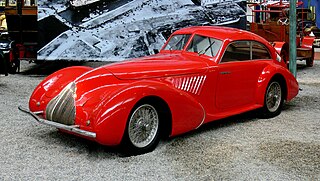
The Alfa Romeo 8C was originally a range of Alfa Romeo road, race and sports cars of the 1930s. In 2004 Alfa Romeo revived the 8C name for a V8-engined concept car which made it into production for 2007, the 8C Competizione.

Alfa Romeo Giulia is the name of three not directly related models by the Italian car manufacturer Alfa Romeo. The first is a line of sporty four-door compact executive cars produced from 1962 to 1978, the second is an updated, mainly up-engined Spider, Sprint and Sprint Speciale Giuliettas, and the third Giulia is a compact executive car unveiled in 2015.

The Alfa Romeo 2000 is a luxury car produced by Italian car manufacturer Alfa Romeo between 1958 and 1962, as a successor to the 1900 Super. It was replaced in 1962 by the Alfa Romeo 2600.

The Alfa Romeo Alfasud Sprint is a boxer-engined coupé produced by the Italian manufacturer Alfa Romeo from 1976 to 1989, and based on the Alfa Romeo Alfasud. 116,552 units of the Alfasud Sprint and Sprint were built in total. The Sprint was sold in Europe, South Africa, Australia, and New Zealand.
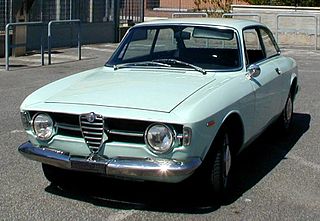
The Alfa Romeo 105 and 115 series coupés are a range of cars made by the Italian manufacturer Alfa Romeo from 1963 until 1977, based on a shortened floorpan from the Giulia saloon. They were the successors to the Giulietta Sprint coupé.

The Alfa Romeo 33 Stradale is a mid-engined sports car built by Italian car manufacturer Alfa Romeo. It is one of the world's first supercars; it was the fastest commercially available car for the standing kilometer when introduced. 18 examples were produced between 1967 and 1969. "Stradale" is a term often used by Italian car manufacturers to indicate a street-legal version of a racing car; indeed the 33 Stradale was derived from the Tipo 33 sports prototype.

The Alfa Romeo Giulietta was a family of automobiles made by Italian car manufacturer Alfa Romeo from 1954 to 1965 which included a 2+2 coupé, four-door saloon, estate, spider, Sprint, and Sprint Speciale. The 2+2 was Alfa Romeo's first successful foray into the 1.3-litre class. From 1954 to 1965 a total of 177,690 Giuliettas were made, the great majority in saloon (Berlina), Sprint coupé, or Spider body styles, but also as Sprint Speciale and Sprint Zagato coupés, and the rare Promiscua estate.
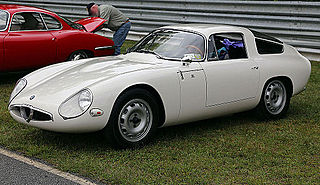
The Alfa Romeo Giulia TZ was a sports car and racing car manufactured by Alfa Romeo from 1963 to 1967. It replaced the Giulietta SZ. In 2011, the name was reduced from Giulia TZ to TZ in the new TZ3 model.
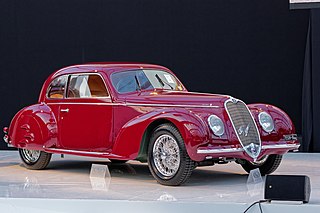
The Alfa Romeo 6C name was used on road, race, and sports cars produced between 1927 and 1954 by Alfa Romeo; the "6C" name refers to the six cylinders of the car's straight-six engine. Bodies for these cars were made by coachbuilders such as James Young, Zagato, Touring Superleggera, Castagna, and Pinin Farina. Beginning in 1933 there was also a 6C version with an Alfa factory body, built in Portello. In the early 1920s Vittorio Jano received a commission to create a lightweight, high performance vehicle to replace the Giuseppe Merosi designed RL and RM models. The car was introduced in April 1925 at the Salone dell' Automobile di Milano as the 6C 1500. It was based on Alfa's P2 Grand Prix car, using a single overhead cam 1,487 cc in-line six-cylinder engine, producing 44 horsepower. In 1928 the 1500 Sport was presented, which was the first Alfa Romeo road car with double overhead camshafts.
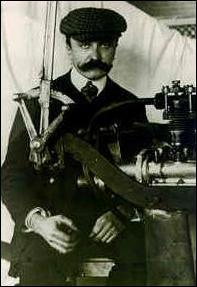
Giuseppe Merosi was an Italian automobile engineer and designer.

ALFA 40/60 GP or GP was a fully working early racing car prototype made by the company now called Alfa Romeo. Only one example was built in 1914, which was later modified in 1921. This was the creation of Giuseppe Merosi and was the first Alfa Romeo DOHC engine. It had four valves per cylinder, 90 degree valve angle and twin spark ignition. Usually Alfa Romeo DOHC engines are thought to be Vittorio Jano's creations but the first one was Merosi's GP car. This kind of engine architecture was very new for the time, originating from 1912/1913 Peugeot designed by Swiss engineer Ernest Henry. The history of this engine architecture is unclear, but other cars with dual overhead camshafts were made by Sunbeam, Delage and Humber. This 1914 GP car was intended to take part in the French Grand Prix of that year, but for reasons unknown this never happened. In 1921 Giuseppe Campari took part in the Gentlemen G.P. in Brescia with the modified GP car, but was forced to retire due to a leaking radiator.
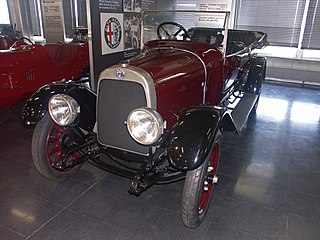
ALFA or later Alfa Romeo has made three cars named as 20/30 HP, first one 1910 4-cylinder 4-6-seater tourer, improved version 20/30 HP E in 1914 and 1921 the 20/30 HP ES Sport, a 4-seater sportscar.

The Alfa Romeo G1 (1921–23) was an Italian automobile.

The ALFA 40/60 HP is a road car and race car made by Italian car manufacturer ALFA. This model was made between 1913 and 1922 and was designed by Giuseppe Merosi, as were all other Alfas at that time. The 40/60 HP has a 6082 cc straight-four engine with overhead valves, which produced 70 PS (51 kW) and its top speed was 125 km/h (78 mph). The 40-60 HP Corsa racing version had 73 PS (54 kW) and a top speed of 137 km/h (85 mph), and it also won its own category in the Parma-Berceto race.

The Alfa Romeo Gran Sport Quattroruote is a two-seater roadster made between 1965 and 1967 by Italian car manufacturer Alfa Romeo and the coachbuilder Zagato. The car wears retro bodywork by Zagato, replicating the Alfa Romeo 6C 1750 Gran Sport Spider Zagato of the early 1930s, over then-modern Alfa Romeo Giulia mechanicals. Just 92 were made.

The Alfa Romeo 1900 C52 "Disco Volante", commonly known simply as Alfa Romeo Disco Volante, is a series of experimental sports racing cars produced between 1952 and 1953 by Italian car manufacturer Alfa Romeo in collaboration with Milanese coachbuilder Carrozzeria Touring. The car was distinguished by streamlined, wind tunnel tested bodywork.
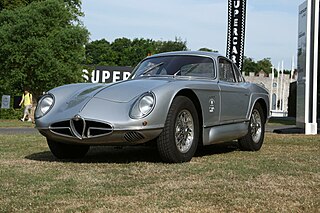
The Alfa Romeo 2000 Sportiva is a 2-litre sports car made by Italian car manufacturer Alfa Romeo in 1954. Although developed to be built in a small series, just four were made — two coupés and two spiders.

The Alfa Romeo Spider is a two-seater, front engine, rear drive roadster manufactured and marketed by Alfa Romeo from 1966 to 1994 in four distinct generations, or Series, each with modifications ranging from modest to extensive.

The Alfa Romeo Giulietta Sprint Speciale and Alfa Romeo Giulia Sprint Speciale, also known as Giulietta SS and Giulia SS, are small sports cars manufactured by Alfa Romeo from 1959 to 1966.






















